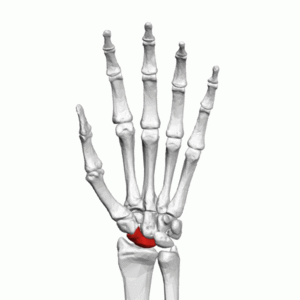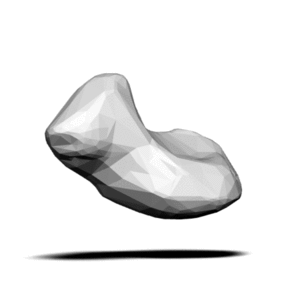Scaphoid: Difference between revisions
Nina Myburg (talk | contribs) (Content) |
No edit summary |
||
| (16 intermediate revisions by 4 users not shown) | |||
| Line 1: | Line 1: | ||
<div class="editorbox"> | <div class="editorbox">'''Original Editor'''- [[User: Nina Myburg| Nina Myburg]] | ||
'''Original Editor''' | '''Top Contributors''' - {{Special:Contributors/{{FULLPAGENAME}}}}</div> | ||
'''Top Contributors''' - {{Special:Contributors/{{FULLPAGENAME}}}} | |||
</div> | |||
== Description == | == Description == | ||
The | The scaphoid is the largest bone of the proximal row of carpal bones.<ref name=":1">Moore KL, Dalley AF. ''Clinically Oriented Anatomy.'' Fifth edition. Philadelphia: Lippincot Williams & Wilkins; 2006</ref> The word scaphoid is derived from the Greek word ''skaphos'' which means "a boat". The name refers to the boat-like shape of the bone. Previously it was called the navicular bone (derived from the Latin word ''navis'' which means "boat") of the hand. However, there is a tarsal bone in the foot that is also called navicular due to its boat-like shape. The scaphoid is situated at the radial side of the wrist.<ref name=":0">Gray H. ''[https://www.bartleby.com/107/54.html Anatomy of the Human Body].'' Twentieth edition. Philadelphia: Lea & Febiger; 1918 Available from: https://www.bartleby.com/107/54.html [Accessed 19 June 2019]</ref> | ||
The scaphoid is situated | |||
[[File:Scaphoid bone (left hand) - animation.gif|center|thumb|Scaphoid bone (animation) - Left hand]] | |||
=== Structure === | |||
The scaphoid is situated below the [[radius]] at the radial (lateral) side of the [[Wrist and Hand|wrist]]. It has a boat-like shape with many articulation surfaces. Over 80% of the bone is covered in cartilage. On the palmar surface of the bone, there is a tubercle that can be palpated at the base and medial aspect of the thenar eminence when the hand is extended. <ref name=":1" /> It can also be palpated at the base of the anatomical snuffbox. | |||
[[File:Scaphoid bone (picture of only the bone) - animation1.gif|center|thumb|Scaphoid bone]] | |||
The | == Function == | ||
The scaphoid, together with other carpal bones, provide bony structure to the hand and wrist. It is involved in the movement of the wrist together with the [[lunate]] and distal surfaces of the [[radius]] and [[ulna]]. It forms the radial border of the carpal tunnel and serves as attachment site. | |||
== | == Articulations == | ||
<ref name=":0"> | The scaphoid articulates with five bones:<ref name=":0" /> | ||
* [[Radius]] (proximally) | |||
* [[Trapezoid]] and [[trapezium]] (distally) | |||
* [[Capitate]] and [[Lunate]] (medially) | |||
== | == Soft tissue attachments == | ||
* The transverse carpal ligament attaches to the tubercle of the [[scaphoid]] | |||
* Sometimes a few fibres of [[Abductor Pollicis Brevis|abductor pollicis brevis]] attaches to the tubercle of the [[scaphoid]] | |||
* The radial collateral ligament attaches to the lateral surface | |||
== | == Clinical relevance == | ||
Clicking of the scaphoid or no anterior translation can indicate scapholunate instability. | |||
== | == See also == | ||
[[Scaphoid Fracture]] | |||
[[Scapholunate Dissociation]] | |||
[[Scaphoid shift test]] | |||
== | == References == | ||
= | |||
<references /> | <references /> | ||
[[Category:Anatomy]] | [[Category:Anatomy]] | ||
[[Category:Anatomy Project]] | |||
[[Category:Wrist - Anatomy]] | |||
[[Category:Wrist - Anatomy]] | |||
[[Category:Bones]] | [[Category:Bones]] | ||
[[Category:Wrist - Bones]] | |||
[[Category:Wrist]] | [[Category:Wrist]] | ||
Latest revision as of 20:05, 21 July 2022
Description[edit | edit source]
The scaphoid is the largest bone of the proximal row of carpal bones.[1] The word scaphoid is derived from the Greek word skaphos which means "a boat". The name refers to the boat-like shape of the bone. Previously it was called the navicular bone (derived from the Latin word navis which means "boat") of the hand. However, there is a tarsal bone in the foot that is also called navicular due to its boat-like shape. The scaphoid is situated at the radial side of the wrist.[2]
Structure[edit | edit source]
The scaphoid is situated below the radius at the radial (lateral) side of the wrist. It has a boat-like shape with many articulation surfaces. Over 80% of the bone is covered in cartilage. On the palmar surface of the bone, there is a tubercle that can be palpated at the base and medial aspect of the thenar eminence when the hand is extended. [1] It can also be palpated at the base of the anatomical snuffbox.
Function[edit | edit source]
The scaphoid, together with other carpal bones, provide bony structure to the hand and wrist. It is involved in the movement of the wrist together with the lunate and distal surfaces of the radius and ulna. It forms the radial border of the carpal tunnel and serves as attachment site.
Articulations[edit | edit source]
The scaphoid articulates with five bones:[2]
Soft tissue attachments[edit | edit source]
- The transverse carpal ligament attaches to the tubercle of the scaphoid
- Sometimes a few fibres of abductor pollicis brevis attaches to the tubercle of the scaphoid
- The radial collateral ligament attaches to the lateral surface
Clinical relevance[edit | edit source]
Clicking of the scaphoid or no anterior translation can indicate scapholunate instability.
See also[edit | edit source]
References[edit | edit source]
- ↑ 1.0 1.1 Moore KL, Dalley AF. Clinically Oriented Anatomy. Fifth edition. Philadelphia: Lippincot Williams & Wilkins; 2006
- ↑ 2.0 2.1 Gray H. Anatomy of the Human Body. Twentieth edition. Philadelphia: Lea & Febiger; 1918 Available from: https://www.bartleby.com/107/54.html [Accessed 19 June 2019]








